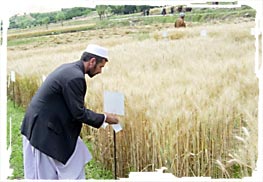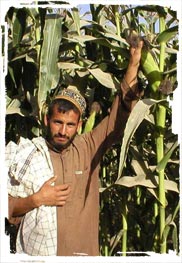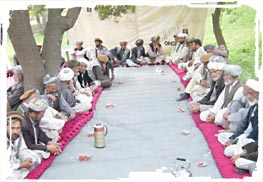CIMMYT E-News, vol 2 no. 8, August 2005

“The maize brought by CIMMYT and implemented by Kunduz Rehabilitation Agency is doing wonders.”
Years of war (1979-1989) and subsequent internal instability, plus a prolonged drought and an earthquake, devastated Afghanistan’s agricultural infrastructure, production capacity, and agricultural research capabilities. As a result, agricultural production fell to an estimated 45% of 1978 levels, with crop yields declining to about 50% of pre-war levels.
Wheat is the number-one staple crop in Afghanistan, and maize is the third. Together they occupy 80% of the area planted to annual crops in the country. A central aim of CIMMYT in Afghanistan is to make improved, high quality seed of both crops available to farmers, along with appropriate crop management technologies. To date CIMMYT has responded to Afghanistan’s most urgent needs by:
- Distributing 300 tons of quality seed of the locally-adapted wheat MH-97 to 9,000 farmers in four provinces of Afghanistan.
- Producing and delivering tons of breeder’s and foundation maize seed.
- Planting 35 wheat variety trials at 6 sites and 24 maize trials at 8 sites to identify additional materials suited to farmers’ needs.
- Training Afghan researchers through courses in-country and at CIMMYT in Mexico.
CIMMYT has collaborated with Afghan researchers for over three decades—even during the war. Thanks to the Swedish Committee for Afghanistan and the FAO, Afghan researchers maintained contact with the Turkey-CIMMYT-ICARDA International Winter Wheat Improvement Program (IWWIP) and continued to select the best new wheats from international nurseries. The new seed moved from farmer to farmer; without it, people would have suffered even more hunger and malnutrition than they did. All winter and facultative wheat cultivars currently registered in Afghanistan are derived from those nurseries. In total, several hundred CIMMYT wheat and maize nurseries have been evaluated in Afghanistan over the past 30 years.
Recent Update from the Field
 An important component of a current ACIAR-funded project (“Wheat and Maize Productivity Improvement in Afghanistan”) has included collaborative work with farmers and non-government and international organizations to verify in farmers’ fields the performance and acceptability of improved wheat and maize varieties. For wheat, the project uses two approaches:
An important component of a current ACIAR-funded project (“Wheat and Maize Productivity Improvement in Afghanistan”) has included collaborative work with farmers and non-government and international organizations to verify in farmers’ fields the performance and acceptability of improved wheat and maize varieties. For wheat, the project uses two approaches:
- A traditional approach where demonstrations are planted in farmers’ fields and the farmer assessments are recorded informally through topic focused interviews during field days. The varieties included in these demonstrations are released in the country and made available where security allows. Using this approach in Parwan Province, farmers showed a keen interest for the variety ‘Sohla,’ which yielded well and showed superior resistance to diseases like rust. The project is helping to ensure that demand for seed of the variety is met.
- A participatory technology development approach implemented by the Aga Khan Foundation brings farmers to research stations to observe yield trials of promising varieties. Farmers identify preferred varieties with red tags; their assessments determine the selection of wheat lines for advancement and subsequent release.
For maize, the project provided non-government organizations with seed of open-pollinated varieties that were distributed to rural communities. Farmer testing and feedback resulted in the identification of two promising varieties: Rampur 9433 and PozaRica 8731. Farmers said the varieties performed well but did not mature quickly enough to fit local cropping systems, so project participants are identifying earlier-maturing varieties. To offer farmers sufficient seed, the project is pursuing two approaches:
- A formal scheme whose main partners are the Agricultural Research Institute of Afghanistan (ARIA) and the FAO, through the Improved Seed Enterprise (ISE), and under which breeder’s seed will be offered to recognized producers of certified seed.
- Informal farmer-to-farmer distribution systems, which have resulted in up to a 10-fold increase in some areas under improved varieties. For example, the Norwegian Project Office-Rural Rehabilitation Association for Afghanistan (NPO-RRAA) reported that farmers who had planted open-pollinated varieties from the project in 2003 had bartered and sold more than two tons of seed of the varieties in 2004.

The project has built human capacity through in-country, technical workshops, five of which have been conducted since 2000 on topics including: agricultural development potential and constraints in specific zones; yellow rust and field scoring for the disease; research methodologies; variety evaluation; and several field days. The workshops have drawn 70 participants, including farmers, workers from non-government organizations, and officers from research stations.
CIMMYT partners in Afghanistan include:
- The Future Harvest Consortium to Rebuild Agriculture in Afghanistan, funded by USAID and coordinated by ICARDA.
- AusAID and the Australian Centre for International Agricultural Research (ACIAR).
- The FAO.
- The International Fertilizer Development Center (IFDC)-USAID.
- The French non-government organization, ACTED.
- The Aga Khan Development Network.
- Improved Seed Enterprise.
- The Afghan Ministry of Agriculture.
- ARIA.
For further information, contact Mahmood Osmanzai (m.osmanzai@cgiar.org).
This write-up draws on contributions from Alma McNab, former CIMMYT science writer and the CIMMYT team in Afghanistan, including team leader Mahmood Osmanzai and former CIMMYT maize agronomist Julien de Meyer. De Meyer manages the Effective Development Group (EDG), a non-government organization based in Australia and has been commissioned by ACIAR to assist the Afghanistan project in data analysis, training, planning workshops, and reporting.